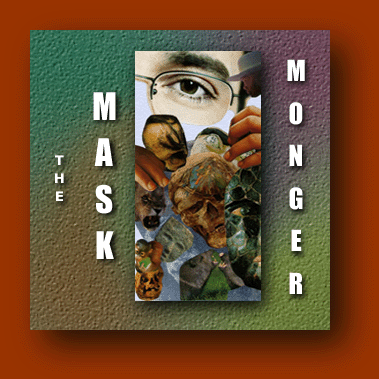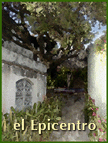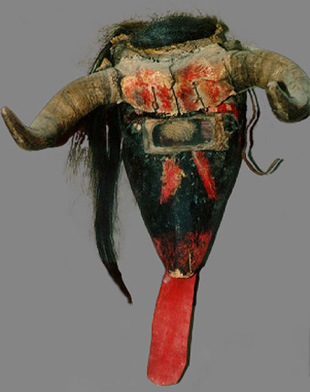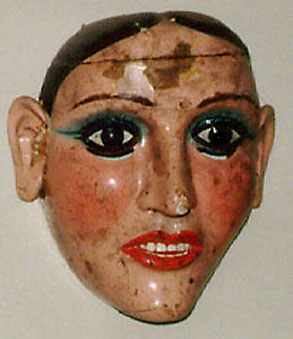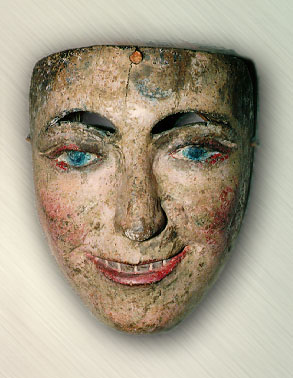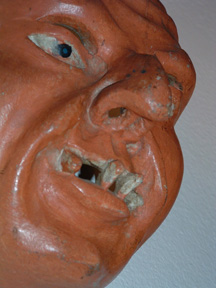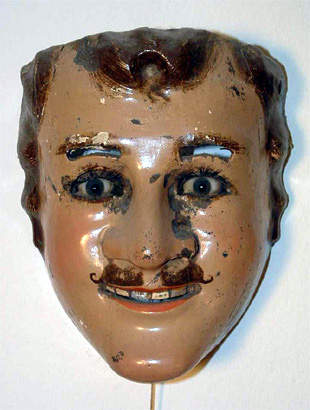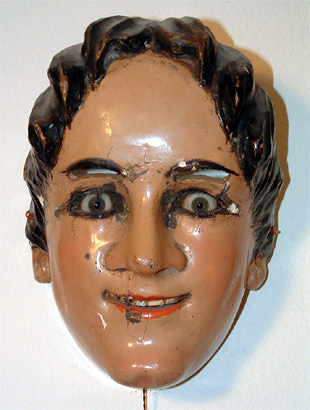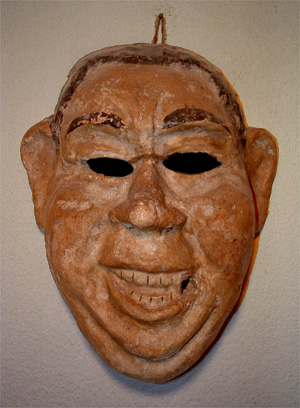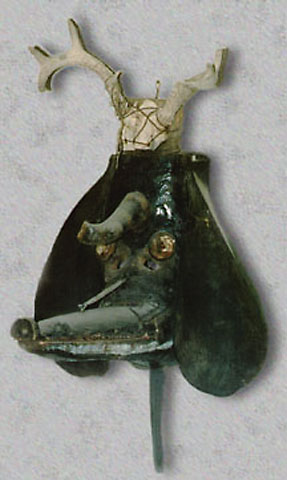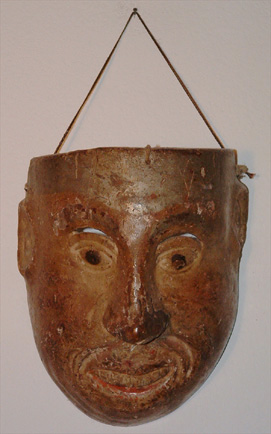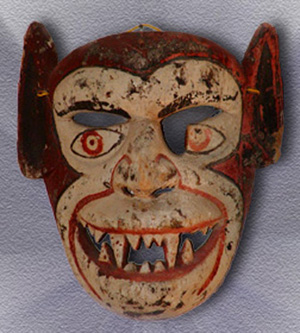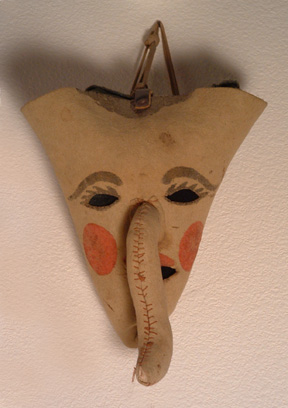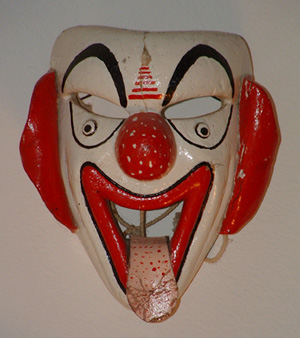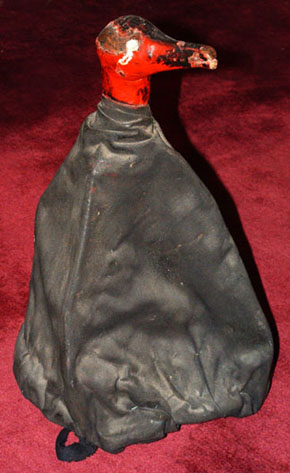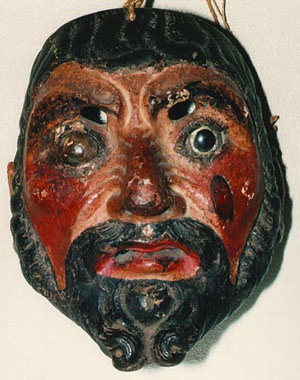
|
Dance of the Christians & Moors - Guatemala
Fine old masks such as this are highly valued by collectors and museums. Carved in semi-hardwood with glass eyes (one broken), it has miscellaneous repairs and most of its original finish is intact. The mask has been well used and its back (link below) has a rich, dark patina more common to old Guatemalan masks than Mexican ones. The fit is extremely comfortable for a variety of facial shapes.
To a collector, the back of a mask is sometimes more important than the front. An authentic, old patina on the back is a testimony to the mask's use in its rightful context. The piece at the left is authentic but with many masks commonly encountered in the marketplace and through dealers, clever techniques have been used by artisan-carvers to create a false patina intended to make the mask seem older or more valuable than it really is. False wear marks, deliberate abuse and subsequent repairs are also used in this crafty craft.
Age: Approx. 100 years.
See also:
Discussion regarding patinas, mask backs and fakery.
Discussion regarding authenticity and collections, click here.
back <---- MASK TOUR ----> continue
----------back to main index |
| 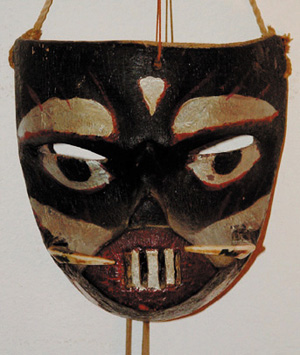       
|

Tusked Negrito - Oaxaca This
Vaderesque mask from Oaxaca is a "Negrito Colmilludo" (tusked little
black one). The Baile de los Negritos Colmilludos is unique to the "Villa
Alta" sierra near the historic pueblo of Yalalag and the dance is well documented
in paintings dating from the 19th century. Negritos Colmilludos are produced in
different styles but most have vertical rectangular cuts in a protruding and sharply
truncated mouth with a tiny curved snout above. Javelin teeth are preferred for
the tusks, (as shown in photo,) but in their absence wood and leather are
used. The eyebrows often have thin, painted striations and the artistic design
is refreshingly absent of Spanish-European influence. The
locals of Yalalag are proud of their Zapotec ancestry. In this mountainous village
of 2,000, the complex and unusual Zapotec dialect is still preferred to spoken
Spanish, reflecting their independent mindset as a people. If you ever want to
see Yalalag, it takes six uncomfortable hours on a bumpy dirt road to get there
from Oaxaca city and don't count on the usual gas stations, restaurants or bathrooms.
You will, however, find conveniently located "pulque stands" along the
road. Pulque is an ancient beverage made from the fermented maguey plant and belting
down a few shots helps the uncomfortable traveler overlook any inconveniences. Age:
Approx. 50 years.
See also:
Striking similarity of this mask to a very familiar face.
Click to see another old Negrito Colmilludo.
Count to fifty in Zapotec? Click to hear authentic sample of Zapotec language.
Note: many sounds in the Zapotec dialect can't be captured
phonetically
with
our Roman alphabet.
back
<----
MASK TOUR ---->
continue
----------back
to main index |
| |
Pastorela
Devil Mask - Zacatecas Purchased
at a ranchito outside Zacatecas in the late 80's, this Pastorela Devil is particularly
charming in its naive and unpretentious composition, utilizing a single glass
visor eye opening, animal horns, a cloth tongue and horse hair headdress.
One
can easily recognize that this mask was, without question, produced in its rightful
context for use in the local dances. Its sale was never contemplated by its owner,
which can be seen as a desirable and important quality.
Age:
approx. 50 years. back
<----
MASK TOUR ---->
continue
----------back
to main index |
| |
La
Borracha, El Torito Dance, Guanajuato In
many a man's past there lurks a woman such as "La Borracha " (the drunken
woman) of the Baile del Torito (Dance of the Little Bull). If you are such
a man, please take a brief moment now to remember her and the good times you spent
together...
La Borracha is characterized by an oversized, garish mask with heavy lipstick,
eye makeup, rouged cheeks and wig (not shown). Some might think of her
as a tart. The complex El Torito dance has an unusual cast of colorful characters including hunchback, hermit and "El
Torito" a body mask of a bull worn over the back of a small person.
Age: Approx.
35 years. back
<----
MASK TOUR ---->
continue
----------back
to main index |
|
|
Man's
mask from Guerrero Very
old, beautifully carved and delicately painted. The back is nice also, heavily
worn and comfortable. The facial expression is angelic and serene. It's difficult
to tell if the mask represents a man or a woman - although it is likely a catrín,
a dandy. I can't say much else about this piece except that it's one of the favorites
of my collection. Age:
over 60 years old. back
<----
MASK TOUR ---->
continue
----------back
to main index |
|
|

Dance of the Viejitos, Michoacan
The over-performed "Baile de los Viejitos" (Dance of the Llittle Old Men) is a seemingly playful festivity staged by both adults and children, particularly in the state of Michoacan. In spite of a happy ending, the tiring fandango has no real utility other than to mock a bevy of little old men, all dancing - or better to say hobbling - with feeble knees and canes while simultaneously making lecherous fools of themselves.
I'm not a whistleblower but I can't understand why the elderly and the handicapped - true victims of this cruel pageant - have not uttered a single word of protest up to now; perhaps they're just too intimidated by the dance's widespread popularity to complain; thus the Baile de los Viejitos continues in its long-standing tradition as a cute and endearing icon of Mexican culture.
Age:
Approx. 40 years.
See also:
A strange viejito experience in Oaxaca.
back
<----
MASK TOUR ---->
continue
----------back
to main index 
|
| |
Dance
of the Catrines or Paragueros, Tlaxcala Master
craftsmen of the state of Tlaxcala create some of Mexico's finest carved wooden
lacquer work in these realistic masks which are used in several different dances.
The most common are the Baile de los Catrines (Dance of the Dandies) and
also the Baile de los Paragueros (Dance of the Umbrella Salesmen.) An extremely
smooth, reflective finish is facilitated by use of a gesso undercoat applied to
the wood, making fine sanding and shaping easier for the carver. A
distinguishing feature of the mask shown at left are the "operable eyelids"
which open and close by pulling a string at the chin. This is accomplished by
a clever spring mechanism (click here)
probably borrowed from European doll making techniques. The eyes are glass and
the eyelids have lashes. Age:
Approx. 50 years. back
<----
MASK TOUR ---->
continue
----------back
to main index |
|
|
Dance
of the Catrines or Paragueros, Tlaxcala This
lovely lady is the female counterpart of the above mask. Tlaxcala
has some renown in Mexican history. During the conquest of Mexico by Cortez in
the early 1500's, Tlaxcalan tribes, unfriendly with the Aztecs, abetted the Spanish
in their invasion of the valley of Mexico and thus contributed significantly to
the ultimate defeat of the Aztec empire. Deeply
rooted resentment and alienation are said to be felt by some Mexicans to this
day - but I say to anyone who still feels miffed by the Tlaxcalan's infamous deed
- just let bygones be bygones. After all, anyone can make a blooper, right? Age:
Approx. 50 years.
back
<----
MASK TOUR ---->
continue
----------back
to main index |
|
|
Carnival
Mask, Guanajuato This
papier mache mask was purchased from a mascarero (mask maker) in Guanajuato.
Some people think that the face is that of a Mexican movie actor or politician.
I personally think it looks like Richard
Nixon during a smiling moment. Well, maybe not quite, but I think there is
a slight resemblance in the expression.
The Guanajuato
maskmaker had his original mask molds which were carved out of wood, serving
as a form for the layers of paper. Carnival masks are frequently made
from molds, using either papier mache, plastic or cloth. Because of their
low cost, many consider them to be throwaway masks; and for this reason,
it is unusual to find a nice old one like this because they are usually
broken and discarded within a few years.
Age: Approx.
40 years. back
<----
MASK TOUR ---->
continue
----------back
to main index |
| | Pastorela
Devil Mask - Jalisco When
the proprietor of this mask ordered it from the carver, he said, "by the
way, super size that for me, please." This formidable piece is big - I mean
really big. The ears are made from black rubber inner tubes and the upper half
of the long snout articulates via a cord attached to the top. This
mask demonstrates the relaxed artistic whimsy which I feel distinguishes Mexican
ethnic art in Latin America. I do not find this quality of whimsy in Guatemalan
masks, for example, but many would argue the point. Although Guatemala is a major
player in finely carved Latin American masks, I personally find their masks to
be more predictable, stylistically uniform and restrained than their Mexican counterparts. Approximate
age: 35 Yrs.
See also:
For
a further discussion of Guatemala, click here - if you dare.
back
<----
MASK TOUR ---->
continue
----------back
to main index |
|
|
Old
Mask - Mexico, (origin unknown) This
enigmatic mask is what I call a "bedroom piece." While searching for
high quality masks in the Mexico City area, visiting the home gallery of an ethnic
art dealer and his wife, the bedroom piece is the one he doesn't really want to
sell to you. A
clever one he is, so he keeps it in his bedroom thinking you won't find it. But
aha, you do find it - on the way to the bathroom - and catching him off guard,
you joke him about "hiding" it from you - and you can then buy it for
a noble price. A
true mask monger will do anything to get a piece he really wants - and this mask,
even with its ambiguous past, is to kill for. The patina is extraordinary and
the original finish is intact. The distinctive carving and a deliberately naive
expression add to its charm.
Age: Approx. 75 Years back
<----
MASK TOUR ---->
continue
----------back
to main index |
|
| 
Demon Mask, Naolinco, Veracruz As
the thin young man and I stood outside his house on the narrow street of Naolinco,
I couldn't help but notice that his pants were several inches too short. He handed
me the mask and I felt its lightness in weight - sometimes a negative characteristic
- but this wood was tight grained and of good quality. Most devils and demons
one encounters are usually much newer - and made primarily for the purpose of
sale. So it was a pleasant surprise to find a nice old monkey demon which had
been well used in its rightful context. I
asked how much he wanted for
it and was a little taken back by his price, which amounted to about three month's
pay for the lad. But he went on to explain that the mask had sentimental value,
having belonged to a now deceased uncle who used to dance in the local festivities.
So after a brief chat we finalized the transaction - and in fond reverence for
the uncle, he stood firm by his price.
Age: Approx.
40 years.
See also:
Other "My Dead Uncle Masks"
back
<----
MASK TOUR ---->
continue
----------back
to main index


|
|
|
Jorobado or
Ermitaño, Baile del Torito, Guanajuato The
hunchback and hermit are important characters in the Dance of the Little Bull. Distinct
from the La Borracha (painted wood) mask shown above, this piece is resourcefully
fashioned from a piece of hatters felt, riveted with leather straps and a stuffed
and carefully stitched undulating snout. The well worn mask also captures, in
its simplicity, a fine example of Mexican whimsical art.
El
Baile del Torito is of a humorous nature in its mockery of past Spanish corruption
and decadence. I believe the dance is most common in the state of Guanajuato in
cities such as Silao, but it may possibly be performed elsewhere. This
mask was purchased in the early 80's from a family of Torito dancers in Silao,
Guanajuato. Their colorful masks were mostly made of papier mache and included
a La Borracha mask (not shown) with a large wig which was suitably garish and
cheap. Age:
approximately 35 years.
See also:
Family of torito dancers.
back
<----
MASK TOUR ---->
continue
----------back
to main index


|
|
|

Clown Mask, Veracruz
This
payaso from Naolinco is of a 19th century European "auguste" style,
but jesters and clowns have existed in the pre-Hispanic Americas and most parts
of the world since ancient times. With
enhanced freedoms of expression and relative immunity from reprisals, the clown
can be a de facto spokesperson for the collective conscience, using parody and
acerbic humor to ridicule authority or even shame the benefactors they serve.
Their function is thus more profound than merely causing us to laugh. This
mask is carved from a dense wood and has a leather tongue and folded leather ears.
I particularly enjoy the carver's simple detail work as used in the eyes, which
are carved in relief and protrude like buttons. Age:
Approx. 40 years. back
<----
MASK TOUR ---->
continue
----------back
to main index |
|
|
Mexican
Buzzard Hat Ah
yes, this piece... Well, you see, it's just a regular buzzard hat. Huh? What the
heck is a buzzard hat, you say? The answer is.... nobody seems to know. Another
collector friend of mine also had some buzzard hats and he didn't know either. Age:
Does it matter? back
<----
MASK TOUR ---->
continue
----------back
to main index |
| |

|
